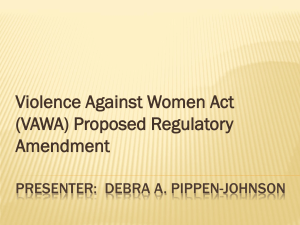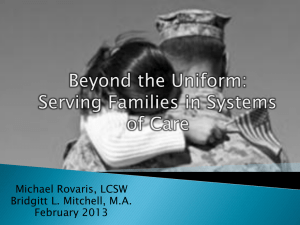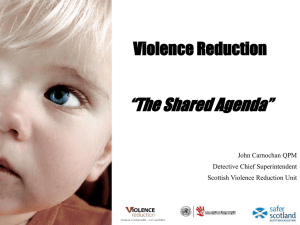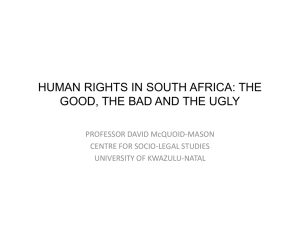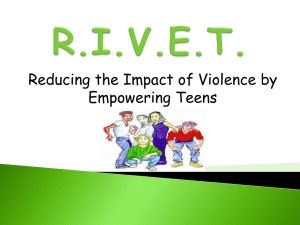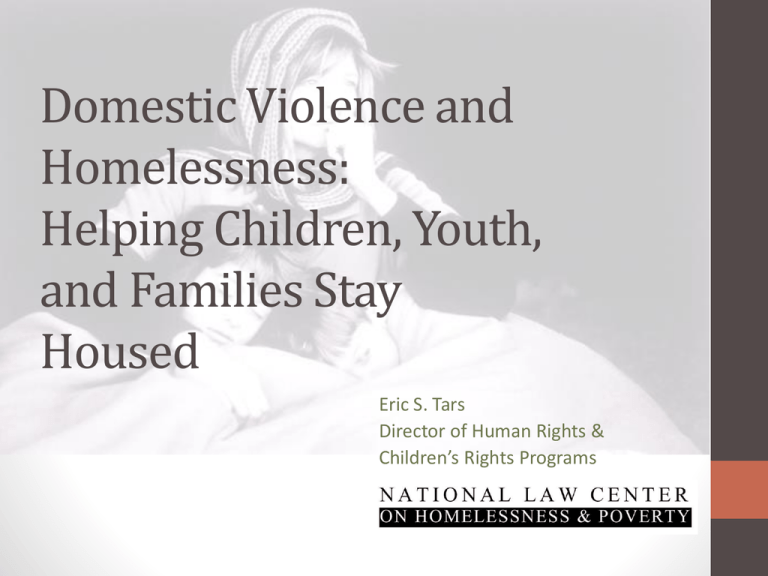
Domestic Violence and
Homelessness:
Helping Children, Youth,
and Families Stay
Housed
Eric S. Tars
Director of Human Rights &
Children’s Rights Programs
Overview
• Domestic Violence & Homelessness
• Background
• The Violence Against Women Act
• Housing Protections for Survivors and their Children
• Education & Homelessness
• Education Protections for Homeless Children Fleeing Domestic
Violence
• Putting it Together
• Q&A
DOMESTIC VIOLENCE & HOMELESSNESS
Domestic Violence & Homelessness
• 80% of families in homelessness are female-headed
• 50%+ of homeless mothers do not have a high school diploma
• 29% of adults in homeless families work
• 92% of homeless mothers have experienced severe physical
and/or sexual abuse
• 63% was perpetrated by intimate male partner
• 94% of homeless children are in homeless families
• Domestic violence a “primary cause of homelessness” in 16
cities
Causes of Family Homelessness
• Extreme poverty
• Insufficient minimum wage earnings
• Families need twice the Federal Poverty Level income to meet
their basic needs
• Lack of affordable, safe housing
• 5.8 million units needed to fill gap
• Wait for public housing or assistance 1.5 – 3 years on average
• Domestic violence
• Difficulty in finding housing due to economic experience of
violence
DV Can Jeopardize Housing
• Eviction threat
• because of criminal activity
• because called police too often
• because of noise of violence
• because of property damage
• because of unauthorized resident
• simply because person is a victim
DV Creates Barriers to Stable Housing
•
•
•
•
•
•
•
•
Need to break lease
Need to transfer housing subsidies
Need to change locks
Lack of steady income
Negative credit history
Prior evictions
Control of lease by abuser
Lack of knowledge of housing protections
VAWA 2005
• Protects the housing rights of applicants and tenants who are
survivors of domestic violence, dating violence, and stalking in
Public Housing and Section 8 units
• Prohibits survivors from being evicted or denied housing
assistance because of acts of violence committed against
them
VAWA 2013
• Explicitly cover survivors of sexual assault
• Expands covered federally assisted housing to cover ALL
federal housing programs
• Mandates that housing authorities create and implement an
emergency transfer policy
• Requires housing authorities to provide notice to tenants on
VAWA rights
Who is covered?
• Any person who is or has been a victim of actual or
threatened domestic violence, dating violence, stalking or
sexual assault as defined by VAWA
• Any person who is protected by state family violence laws
• Immediate family members of the survivor
What rights are afforded?
•
•
•
•
•
•
Rights to confidentiality
Protections in applying for housing
Rights to move or transfer
Protections against evictions and subsidy terminations
Lease/Subsidy bifurcation
Notice
Confidentiality
• Housing providers must keep info survivor provides for
certification confidential
• Housing providers may not enter info into a shared database
or provide to another entity
Protection in Applying for Housing
• Housing providers may not deny an applicant admission to
housing or rental assistance “on the basis that the applicant is
or has been a victim of domestic violence, dating violence, or
stalking.”
• In practice denial is not typically explicit
• VAWA does not explicitly address denials in housing based on
negative tenancy or credit history
Rights to Move or Transfer
• Tenant may continue to receive voucher assistance if a
survivor of violence moved to protect health or safety, and
reasonably believed she was threatened with imminent harm
• VAWA mandates that PHA’s create and implement an
emergency transfer policy
Protections Against Evictions &
Subsidy Terminations
• VAWA provides that criminal activity directly relating to DV
must not be considered cause for eviction or subsidy
termination for the survivor
• Establishes an exception to the federal “one-strike” criminal activity
eviction rule for tenants who are victims.
• 1 act triggers VAWA protections
• Physical act of threat of physical act triggers VAWA protections
Removing Abuser from
Household
• Housing provider can “bifurcate” a lease
• Split the lease in order to evict the perpetrator
• PHA may also terminate section 8 assistance to the
perpetrator while preserving assistance to the survivor
PHA Obligations
• Provide notice of VAWA rights to tenants
• Include VAWA housing protections in the leases, lease
addendums, and housing assistance contracts
• Discuss domestic violence, stalking and sexual assault in 5year and annual plans
• Create and implement an emergency transfer policy for
survivors
State laws
Where state or federal law
is more favorable to victim
than VAWA, more
favorable law governs
State laws
80% allow courts to exclude perpetrator from lease
• California
• Indiana
• Wisconsin
76% protect confidentiality of housing records
• Colorado
• Florida
44% provide rights to emergency shelter
• Florida
• New Hampshire
42% permit early lease termination
• Illinois
State laws
26 % of states have enacted housing anti-discrimination
statutes
• Rhode Island
• District of Columbia
18% of states have enacted statutes that provide survivors
with a defense against eviction
• District of Columbia
• Washington
State laws – key recommendations
Specify activities that constitute discrimination
Require landlords to bifurcate lease at survivor’s request
Create a private right of action based on state law for
violations of housing protections
Mandate PHA’s report on terminations of survivors
Create address confidentiality program and exemptions
from public records requirements
Require employers to provide leave from work to
relocate or improve safety
State laws
26 % of states have enacted housing anti-discrimination
statutes
• Rhode Island
• District of Columbia
18% of states have enacted statutes that provide survivors
with a defense against eviction
• District of Columbia
• Washington
EDUCATION & HOMELESSNESS
Who is covered?
• Children who lack a fixed, regular, and adequate nighttime
residence
•
•
•
•
•
Doubled-up, couch surfing
Motels, hotels, camp grounds
Shelters
Abandoned buildings, cars
Awaiting foster care placements
• Families and unaccompanied youth fleeing DV may hide their
status as DV victims – it’s not up to the school to judge
Important Considerations
• Preschool
• Homeless preschoolers are eligible for McKinney-Vento
protections and must be prioritized for Head Start
• Dispute resolution process
• Parent, guardian or youth must be provided notice of
determination and the right of appeal
• Student must be allowed to attend school during the appeal
• Liaison must make sure the process is expeditious
• School records and protecting families
• Encourage schools to protect student privacy (particularly in DV)
PUTTING IT TOGETHER
Putting It Together
• Protecting the housing rights of survivors of domestic violence
not only helps to prevent housing instability for the individual
and their families, but promotes the holistic stability and
improved life outcomes for their children.
• Protecting the education rights of homeless children (often
the witnesses or survivor of domestic violence) is a key
component in ensuring that these children have the skills to
move themselves out of poverty.
• Be aware of opportunities to address
Breaking the Cycle
• Preventing low-income women from becoming homeless
• Domestic violence
• Affordable housing
• Advocacy & legal supports
• Ensuring the right of homeless children to attend school
•
•
•
•
Educational stability
Transportation
Privacy
Other supports
Discussion & Questions
Eric S. Tars, Director of Human Rights & Children’s Rights Programs
(202) 638-2535 x. 120
etars@nlchp.org
nlchp.org
www.facebook.com/homelessnesslaw
www.twitter.com/nlchphomeless

